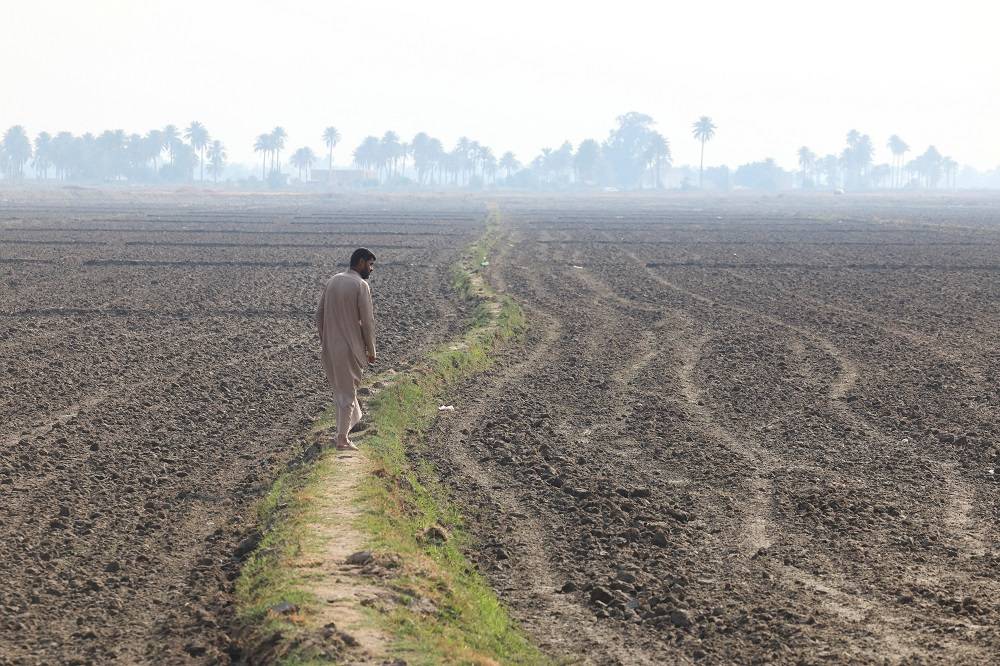More than half the people in this nation of 50 million are suffering from severe hunger. Hundreds are estimated to be dying from starvation and hunger-related disease each day.
But life-saving international aid – cooking oil, salt, grain, lentils and more – is unable to reach millions of people who desperately need it. Among them is Raous Fleg, a 39-year-old mother of nine. She lives in a sprawling displaced persons camp in Boram county, in the state of South Kordofan, sheltering from fighting sparked by the civil war between the Sudanese army and the Rapid Support Forces.
Since Fleg arrived nine months ago, United Nations food aid has gotten through only once – back in May. Her family’s share ran out in 10 days, she said. The camp, home to an estimated 50,000 people, is in an area run by local rebels who hold about half the state.
So, every day after dawn, Fleg and other emaciated women from the camp make a two-hour trek to a forest to pick leaves off bushes. On a recent outing, several ate the leaves raw, to dull their hunger. Back at the camp, the women cooked the leaves, boiling them in a pot of water sprinkled with tamarind seeds to blunt the bitter taste.
For Fleg and the thousands of others in the camp, the barely edible mush is a daily staple. It isn’t enough. Some have starved to death, camp medics say. Fleg’s mother is one of them.
“I came here and found nothing to eat,” said Fleg. “There are days when I don’t know if I’m alive or dead.”
The world has an elaborate global system to monitor and tackle hunger in vulnerable lands. It consists of United Nations agencies, non-governmental aid groups and Western donor countries led by the United States. They provide technical expertise to identify hunger zones and billions of dollars in funding each year to feed people.
Sudan is a stark example of what happens when the final, critical stage in that intricate system – the delivery of food to the starving – breaks down. And it exposes a shaky premise on which the system rests: that governments in famine-stricken countries will welcome the help.
Sometimes, in Sudan and elsewhere, governments and warring parties block crucial aid providers – including the UN’s main food-relief arm, the World Food Program (WFP) – from getting food to the starving. And these organizations are sometimes incapable or fearful of pushing back.
In August, the world’s leading hunger monitor reported that the war in Sudan and restrictions on aid delivery have caused famine in at least one location, in the state of North Darfur, and that other areas of the country were potentially experiencing famine. Earlier, the hunger watchdog, known as the Integrated Food Security Phase Classification (IPC), announced that nine million people – almost a fifth of Sudan’s population – are in a food emergency or worse, meaning immediate action is needed to save lives.
It was just the fourth time the IPC has issued a famine finding since it was set up 20 years ago. But despite this year’s dire warnings, the vast majority of Sudanese who desperately need food aid aren’t getting it. A major stumbling block: the main provider of aid, the United Nations relief agencies, won’t dispense aid in places without the approval of Sudan’s army-backed government, which the world body recognizes as sovereign.
Parts of Sudan have become a “humanitarian desert,” said Christos Christou, the president of Doctors Without Borders, which is active on the ground in Darfur. The UN is in “hibernation mode,” he said.
A RISING DEATH TOLL
People are dying in the meantime: A Reuters analysis of satellite imagery found that graveyards in Darfur are expanding fast as starvation and attendant diseases take hold. More than 100 people are perishing every day from starvation, the UK’s Africa minister, Ray Collins, told parliament this month.
Aid is being distributed far more widely in areas controlled by the army. But relief workers say the military doesn’t want food falling into the hands of enemy forces in areas it doesn’t control and is using starvation tactics against civilians to destabilize these areas. The army-backed government, now based in Port Sudan, has held up aid delivery by denying or delaying travel permits and clearances, making it tough to access areas controlled by an opposing faction.
In internal meeting minutes reviewed by Reuters, UN and NGO logistics coordinators have reported for four months in a row, from May to August, that Sudanese authorities are refusing to issue travel permits for aid convoys to places in South Kordofan and Darfur.
The UN’s reticence to confront Sudan’s government over the blocking of aid has effectively made it a hostage of the government, a dozen aid workers told Reuters.
“The UN has been very shy and not brave in calling out the deliberate obstruction of access happening in this country,” said Mathilde Vu, the Norwegian Refugee Council’s advocacy adviser for Sudan.
Four UN officials, speaking on condition of anonymity, said they fear that if they defy the military, aid workers and agencies could be expelled from Sudan. They point to 2009, when the now-deposed autocrat, Omar al-Bashir, kicked out 13 non-government aid groups after the International Criminal Court issued a warrant for his arrest on war-crimes charges.
A spokesperson for the UN’s emergency-response arm, the Office for the Coordination of Humanitarian Affairs (OCHA), said aid organizations “face serious challenges” in reaching people who need help in Sudan. These include the volatile security situation, roadblocks, looting and “various restrictions on the movement of humanitarian supplies and personnel imposed by the parties to the conflict,” said Eri Kaneko, the OCHA spokesperson.
The World Food Program said it has assisted 4.9 million people so far this year across Sudan. That amounts to just one in five of the 25 million people who are enduring severe hunger. The organization didn’t say how many times these people received aid, or how much each person got.
The army’s main foe, the RSF, is also using food as a weapon, Reuters reporting has shown. The two sides, formerly allies, went to war 17 months ago for control of the country. The RSF has looted aid hubs and blocked relief agencies from accessing areas at risk of famine, including displaced persons camps in Darfur and areas of South Kordofan. The group has also conducted an ethnic cleansing campaign against the Masalit people in Darfur, driving hundreds of thousands from their homes and creating the conditions for famine.
BREAKING THE IMPASSE
Some at the UN are calling on Washington and its allies to do more to break the impasse. Among them is Justin Brady, the Sudan head of OCHA. He says the main donor countries – primarily the United States, the United Kingdom and European Union nations – need to engage directly with the Sudanese government on the ground in Port Sudan. After the army seized power in 2021, the US cut off economic aid to Sudan. Western funding for food aid to the hungry is channeled mainly through the UN.
“It’s the donor governments that have the leverage,” Brady said. “We are left on our own” in dealing with the Sudanese authorities.
The Sudanese military and the RSF are to blame for the country’s food crisis, according to Tom Perriello, the US special envoy to Sudan. “This famine was not created by a natural disaster or drought,” he told Reuters. “It was created by men – the same men who can choose to end this war and ensure unhindered access to every corner of Sudan.”
Sudan’s army-backed government and the RSF didn’t respond to questions for this story. The two warring parties have blamed each other for hold-ups in the delivery of aid. Army chief General Abdel Fattah al-Burhan and RSF leader Mohamed Hamdan Dagalo both said this week they were committed to facilitating the flow of aid.
Another impediment may come from inside the World Food Program itself. The WFP has been rocked by alleged corruption within its Sudan operation, which some humanitarian officials and diplomats worry may have affected aid flows. Reuters revealed in late August that the WFP is investigating two of its top officials in Sudan over allegations of fraud and concealing information from donors about the army’s role in blocking aid.
The disarray in Sudan comes as the global famine-fighting system faces one of its greatest tests in years. The IPC estimates that 168 million people in 42 nations are enduring a food crisis or worse, meaning they live in areas where acute malnutrition ranges from 10% to more than 30% of the populace. Like Sudan, many of the worst hunger zones are also conflict zones – including Myanmar, Afghanistan, South Sudan, Haiti, Nigeria and Gaza. War makes it all the harder for the international community to intervene.
'HUNGER KILLED HER'
Before the war, South Kordofan had some two million people. The need for outside help has intensified as some 700,000 displaced people have poured into camps and towns in SPLM-N areas since the war erupted.
Food stocks in the state were already low before the war. A poor harvest in 2023 was compounded by a locust plague that devoured crops. The war and the resulting refugee influx made things far worse.
In the communities Reuters visited, hunger and disease are everywhere. In one camp in the county of Um Durain, home to some 50,000 people, children have been dying of malnutrition and diarrhea for the past year, said community leader Abdel-Aziz Osman.
Nutrition workers at a treatment center in the camp are seeing 50 cases a month of children and mothers suffering malnutrition. Before the war, medics were treating five to 10 cases of malnutrition a month in the entire county.
In the camp in Boram, toddlers with bloated stomachs and rail-thin arms stood outside huts made of sticks, plastic and clothes – vulnerable to rain, snakes and scorpions.
Raous Fleg, the woman who makes the leafy mush, arrived in the camp from Kadugli, the capital of South Kordofan, in December with her mother and six of her children. She left three of her children behind with her husband, a soldier in the Sudanese army. They made the treacherous journey on foot over a pass in the Nuba Mountains, an area that’s home to a mix of ethnic groups.
Fleg is a member of the Nuba people, who form the main support base of the SPLM-N. Growing up in the Kadugli area, Fleg says, she endured repeated aerial bombardments by government forces.
In the early 2000s, when she was a teenager, fighter jets dropped barrel bombs on her home. Seven members of her family died, including her father and two siblings. She recalls being buried beneath the rubble and getting pulled out alive. Her mother also survived.
“The blood flowed like this,” she said, holding a plastic bottle filled with water and pouring it onto the ground.
Thirteen years later, her in-laws and two more siblings were killed in another air strike by government forces. A third sibling died in hospital after losing two limbs in the attack. Again, she and her mother survived.
After they arrived in Boram county, Fleg’s mother felt weak. There was nothing to eat, so Fleg gave her some water with seeds to drink. But it gave her diarrhea. Doctors at a nearby clinic said her mother was suffering from dehydration and hunger, said Fleg.
On the evening of Jan. 5, Fleg felt her mother’s chest to check if she was still breathing. She wasn’t. After she’d survived years of air strikes, “hunger killed her,” said Fleg.














